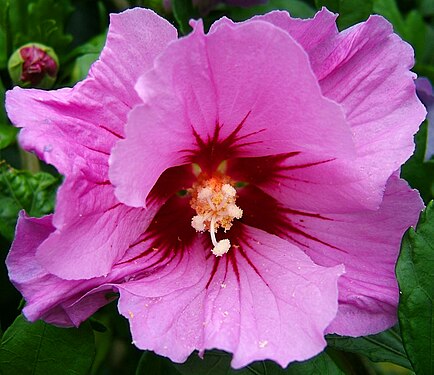Hibiscus syriacus
| Habit | shrub
| |
|---|---|---|
| Height: | ⇕ | 12 ft"ft" can not be assigned to a declared number type with value 12. |
| Width: | ⇔ | 6 ft"ft" can not be assigned to a declared number type with value 6. |
| Lifespan: | ⌛ | perennial |
| Origin: | ✈ | China to India |
| Bloom: | ❀ | late summer, early fall, mid fall |
| Exposure: | ☼ | sun |
|---|---|---|
| Water: | ◍ | moist |
| Features: | ✓ | deciduous, flowers, drought tolerant |
| USDA Zones: | 5 to 9 | |
| Sunset Zones: | 2-21, 26 (north part), 28-41 | |
| Flower features: | ❀ | purple, pink, white, single, double |
|
Hibiscus > |
syriacus > |
A deciduous shrub growing to 3m by 2m at a medium rate.
It is in flower in September, and the seeds ripen in Octoberpf. The flowers are hermaphrodite (have both male and female organs) and are pollinated by insectspf.
Cultivation
Easily grownsn, the plant prefers light (sandy), medium (loamy) and heavy (clay) soils and requires well-drained soilpf. The plant prefers acid, neutral and basic (alkaline) soilspf. It also prefers summer heat and can tolerate some droughtsn. It can grow in semi-shade (light woodland) or full sun. It requires moist soilpf.
Prefers a well-drained humus rich fertile soil in a sheltered position in full sunRH. Succeeds in any soil of good or moderate quality11. Dislikes shade or badly drained soils11. Plants grow best with their roots in cool moist soil and their tops in a hot sunny position. This species is hardy to about -20°cRH but plants only really succeed in the warmer counties of Britain because of their late flowering habit184. When planted in colder areas of the country, they will need protection for the first few wintersRH. The flowers only open in sunny weather219. Plants rarely require pruning219, though they respond well to pruning and trimming and this is best carried out in the spring or just after flowering219. Plants are late coming into leaf, usually around the end of May or early June182. A very ornamental plant1, there are many named varieties182.
Propagation
Seed - sow early spring in a greenhouse. Germination is usually fairly quick. Prick out the seedlings into individual pots when they are large enough to handle and grow them on in the greenhouse for their first year. Plant them out into their permanent positions in late spring or early summer. Some reports say that the seed can be sown in situ outside and that it gives a good rate of germination78, 80, 113. Cuttings of half-ripe wood, July/August in a frame. Good percentage113. Cuttings of mature wood, early autumn in a frame. Good percentage113. Layering in mid summer to early autumn1.
Pests and diseases
Cultivars
- 'Albus' - Flowers pure white. single. 4in.CH.
- 'Anemoniflora' ('Paeoniflora') - Flowers red with deeper red center. Semi-double.CH.
- 'Ardens' - Flowers purple. Double.CH.
- 'Blue Bird' ('Oiseau Bleu') - Flowers blue with dark red eye. Single.CH.
- 'Blushing bride' - Flowers pink, double.CH.
- 'Boule de Feu' - Flowers purple-pink. Double. CH.
- 'Coelestis' - Flowers violet-blue with red-purple center. Single. CH.
- 'Collie Mullens' - Flowers purple-lavender. Double. CH.
- 'Lady Stanley' ('Elegantissimus') - Flowers white, flushed pink going to purple-red center. AH.
- 'Lucy' - Flowers dark rose, with red center. Double. CH.
- 'Meehanii' ('Variegatus') - Flowers lilac-mauve, maroon eye. Leaves have cream margins. AH.
- 'Pink Giant' - Flowers pink with dark red center. Large. AH.
- 'Purpurea' - Flowers purple with red center. Semi-double. CH.
- 'Red Heart' - Flowers white with red center. CH.
- 'William R. Smith' - Flowers white, to 4in (10cm). AH.
- 'Woodbridge' - Flowers dark rose with red center. Single. To 4in (10cm)CH.
More recent introductions bloom for longer periods, and set few/no seedpods. They are sterile triploids.
- 'Aphrodite' - Flowers red-pink with red eye. CH.
- 'Diana' - Flowers all-white. To 5 in (13cm). CH.
- 'Helene' - Flowers white with dark-red center. CH.
- 'Minerva' - Flowers lavender-pink with red eye, ruffled petals,CH 4-5 in (10-13cm). Reaches 8ft (2.5m) high and 7ft (2.2m) wideAH.
Gallery
If you have a photo of this plant, please upload it! Plus, there may be other photos available for you to add.
References
- w:Hibiscus syriacus. Some of the material on this page may be from Wikipedia, under the Creative Commons license.
- Hibiscus syriacus QR Code (Size 50, 100, 200, 500)
- Standard Cyclopedia of Horticulture, by L. H. Bailey, MacMillan Co., 1963
- American Horticultural Society: A-Z Encyclopedia of Garden Plants, by Christopher Brickell, Judith D. Zuk. 1996. ISBN 0789419432
- Sunset National Garden Book. Sunset Books, Inc., 1997. ISBN 0376038608
External links
















